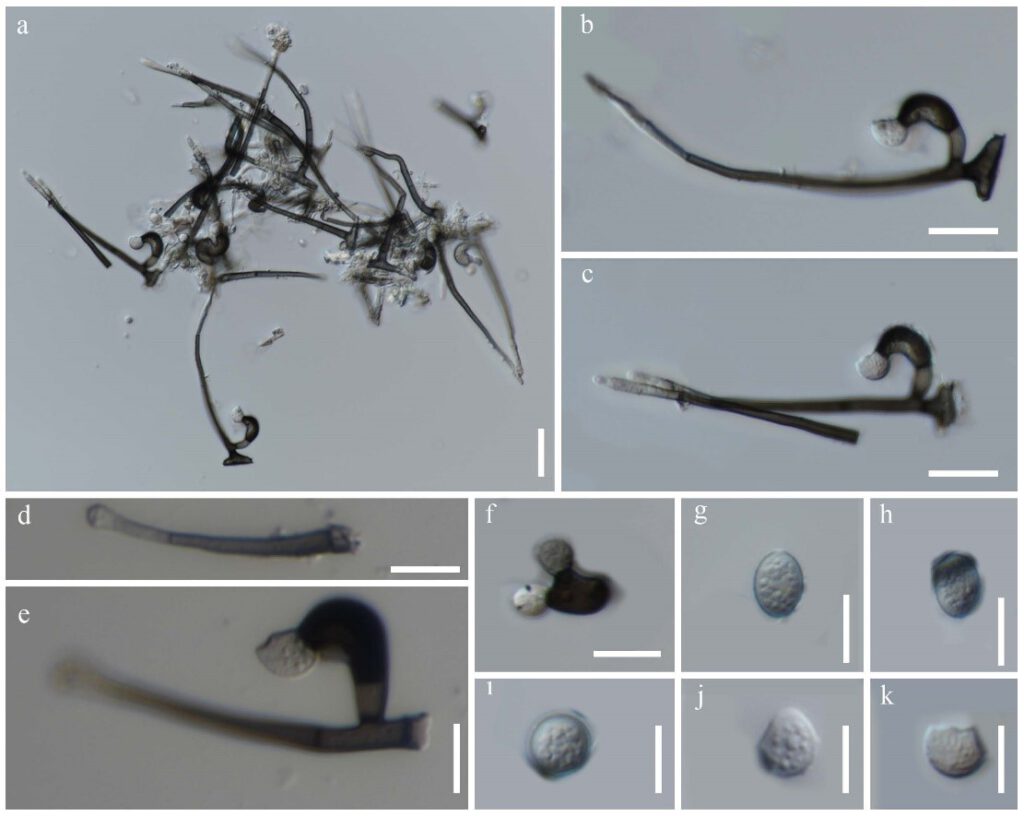Zygosporium dracaenicola Chaiwan & K.D. Hyde, sp. nov.
Index Fungorum number: IF 325704; MycoBank number: MB 325704; Facesoffungi number: FoF 12775, Fig. 1.
Etymology – The specific epithet reflects the host Dracaena sp.
Saprobic on dead leaves of Dracaena sp. Sexual morph: Undetermined. Asexual morph: Hyphomycetous, incurved vesicular cells. Setae and setiform conidiophores in stacked chains of 1–6, each with 2 conidiogenous cells, and a cylindrical sterile cell at the apex (12–36 μm long); that gives rise to ampuliform conidiogenous cells. Vesicular conidiophores are not in stacked chains but are always borne directly on superficial mycelium, with 2–3 conidiogenous cells and a sterile apical cell (7–11 μm long). Conidiophores setiform portion 30–55 × 2–4 μm (x̅ = 42.5 × 2.7 μm, n = 10), macronematous, mononematous, consisting of a setiform portion with a vesicle borne on a short cell near its base, light brown to pale brown, thin-walled, smooth, solitary, or small groups. Conidiogenous cells 8–12 × 3–10 μm (x̅ = 10 × 6.5 μm, n = 20), on the apex of vesicular conidiophores, holoblastic, thick-walled in the dark vesicular cell, light brown to dark brown, smooth, solitary. Conidia 10–12 × 9.2–10 μm (x̅ = 11× 9.6 μm, n = 10), ovoid, hyaline to pale brown, minutely verruculose, smooth to minutely verruculose, solitary, aseptate, globose to ellipsoid, thin-walled.
Material examined – Thailand, Tak Province, Umpang distric, on dead leaves of Dracaena sp., 15 June 2019, Napalai Chaiwan, Nakhon11 (MFLU 22–0125, holotype), 23 August 2019, Napalai Chaiwan, Umpang 3 (MFLU 22–0126).
GenBank accession numbers – MFLU 22–0126 (Umpang3); (Nakhon11) LSU:OM914645; LSU:OM914644
Notes –Zygosporium deightonii has been reported from Cola lateritra var. maclaudii from Sierra Leone (a country in West Africa) (Ellis 1976) but no sequences are available. Based on morphology, we compared them with currently accepted species, and we found that our strains share similarities in vesicular conidiophores with 3 conidiogenous cells and a short, sterile apical cell, stalk with sterile setae, apex hyaline and swollen, conidia ellipsoid, hyaline to pale brown, smooth or verruculose. The similar generic morphology of our strain showed the setae, a sterile apical cell our strains (7–11 μm long) bigger than the holotype (6–8 μm long) conidia, our strains (10–12 × 9.2–10 μm) bigger than holotype (9–15 × 6–9 μm). In this study, we described the morphology and showed the illustrations of Z. deightonii and sequence data. This is a new host record and a new geographical record of Z. deightonii on Dracaena sp. from Thailand. In addition, this is the first time we have provided sequence data for Z. deightonii.

Figure 1 – Zygosporium deightonii (Epitype). a–e Setiform conidiophores with attached vesicular conidiophores. f Vesicular conidiophores showing the two conidiogenous cells. g–k conidia. Scale bars: a = 20 µm. b–k = 10 µm.
